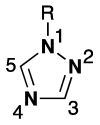Development of Antibacterial and Antifungal Triazole Chromium(III) and Cobalt(II) Complexes: Synthesis and Biological Activity Evaluations
- PMID: 30104466
- PMCID: PMC6222626
- DOI: 10.3390/molecules23082013
Development of Antibacterial and Antifungal Triazole Chromium(III) and Cobalt(II) Complexes: Synthesis and Biological Activity Evaluations
Abstract
In this work, six complexes (2⁻7) of Cr(III) and Co(II) transition metals with triazole ligands were synthesized and characterized. In addition, a new ligand, 3,5-bis(1,2,4-triazol-1-ylmethyl)toluene (1), was synthesized and full characterized. The complexes were obtained as air-stable solids and characterized by melting point, electrical conductivity, thermogravimetric analysis, and Raman, infrared and ultraviolet/visible spectroscopy. The analyses and spectral data showed that complexes 3⁻7 had 1:1 (M:L) stoichiometries and octahedral geometries, while 2 had a 1:2 (M:L) ratio, which was supported by DFT calculations. The complexes and their respective ligands were evaluated against bacterial and fungal strains with clinical relevance. All the complexes showed higher antibacterial and antifungal activities than the free ligands. The complexes were more active against fungi than against bacteria. The activities of the chromium complexes against Candida tropicalis are of great interest, as they showed minimum inhibitory concentration 50 (MIC50) values between 7.8 and 15.6 μg mL-1. Complexes 5 and 6 showed little effect on Vero cells, indicating that they are not cytotoxic. These results can provide an important platform for the design of new compounds with antibacterial and antifungal activities.
Keywords: antibacterial activity; antifungal activity; cobalt(II) and chromium(III) complexes; triazole ligands.
Conflict of interest statement
The authors declare no conflict of interest.
Figures






Similar articles
-
Antibacterial and antifungal metal based triazole Schiff bases.J Enzyme Inhib Med Chem. 2013 Oct;28(5):944-53. doi: 10.3109/14756366.2012.696246. Epub 2012 Jul 18. J Enzyme Inhib Med Chem. 2013. PMID: 22803673
-
Design, synthesis, and biological properties of triazole derived compounds and their transition metal complexes.J Enzyme Inhib Med Chem. 2010 Oct;25(5):737-49. doi: 10.3109/14756360903389906. J Enzyme Inhib Med Chem. 2010. PMID: 20565337
-
Synthesis, spectral characterization, in vitro antibacterial, antifungal and cytotoxic activities of Co(II), Ni(II) and Cu(II) complexes with 1,2,4-triazole Schiff bases.Eur J Med Chem. 2008 Dec;43(12):2639-49. doi: 10.1016/j.ejmech.2008.02.013. Epub 2008 Feb 29. Eur J Med Chem. 2008. PMID: 18395942
-
Thiourea, triazole and thiadiazine compounds and their metal complexes as antifungal agents.J Inorg Biochem. 2005 Aug;99(8):1558-72. doi: 10.1016/j.jinorgbio.2005.05.004. J Inorg Biochem. 2005. PMID: 16005979 Review.
-
Antibacterial activity study of 1,2,4-triazole derivatives.Eur J Med Chem. 2019 Jul 1;173:274-281. doi: 10.1016/j.ejmech.2019.04.043. Epub 2019 Apr 16. Eur J Med Chem. 2019. PMID: 31009913 Review.
Cited by
-
Insights Into the Resistome of Bovine Clinical Mastitis Microbiome, a Key Factor in Disease Complication.Front Microbiol. 2020 Jun 3;11:860. doi: 10.3389/fmicb.2020.00860. eCollection 2020. Front Microbiol. 2020. PMID: 32582039 Free PMC article.
-
Inhibition of C. albicans Dimorphic Switch by Cobalt(II) Complexes with Ligands Derived from Pyrazoles and Dinitrobenzoate: Synthesis, Characterization and Biological Activity.Int J Mol Sci. 2019 Jul 1;20(13):3237. doi: 10.3390/ijms20133237. Int J Mol Sci. 2019. PMID: 31266213 Free PMC article.
-
The Synthesis, Characterization, and Biological Evaluation of a Fluorenyl-Methoxycarbonyl-Containing Thioxo-Triazole-Bearing Dipeptide: Antioxidant, Antimicrobial, and BSA/DNA Binding Studies for Potential Therapeutic Applications in ROS Scavenging and Drug Transport.Biomolecules. 2025 Jun 26;15(7):933. doi: 10.3390/biom15070933. Biomolecules. 2025. PMID: 40723806 Free PMC article.
-
Biological Activity of Complexes Involving Nitro-Containing Ligands and Crystallographic-Theoretical Description of 3,5-DNB Complexes.Int J Mol Sci. 2024 Jun 13;25(12):6536. doi: 10.3390/ijms25126536. Int J Mol Sci. 2024. PMID: 38928242 Free PMC article. Review.
-
In Silico Identification and Validation of Organic Triazole Based Ligands as Potential Inhibitory Drug Compounds of SARS-CoV-2 Main Protease.Molecules. 2021 Oct 14;26(20):6199. doi: 10.3390/molecules26206199. Molecules. 2021. PMID: 34684780 Free PMC article.
References
-
- O’Neill J. Tackling Drug-Resistant Infections Globally: Final Report and Recommendations. [(accessed on 7 August 2018)];2016 Available online: https://amr-review.org/sites/default/files/160518_Final%20paper_with%20c....
-
- Crump J.A., Ramadhani H.O., Morrissey A.B., Saganda W., Mwako M.S., Yang L.Y., Chow S.C., Morpeth S.C., Reyburn H., Njau B.N., et al. Invasive bacterial and fungal infections among hospitalized HIV-infected and HIV-uninfected adults and adolescents in northern Tanzania. Clin. Infect. Dis. 2011;52:341–348. doi: 10.1093/cid/ciq103. - DOI - PMC - PubMed
-
- Richardson M.D., Warnock D.W. Fungal Infection: Diagnosis and Management. John Wiley & Sons; West Sussex, UK: 2012.
MeSH terms
Substances
LinkOut - more resources
Full Text Sources
Other Literature Sources
Medical
Molecular Biology Databases
Miscellaneous

